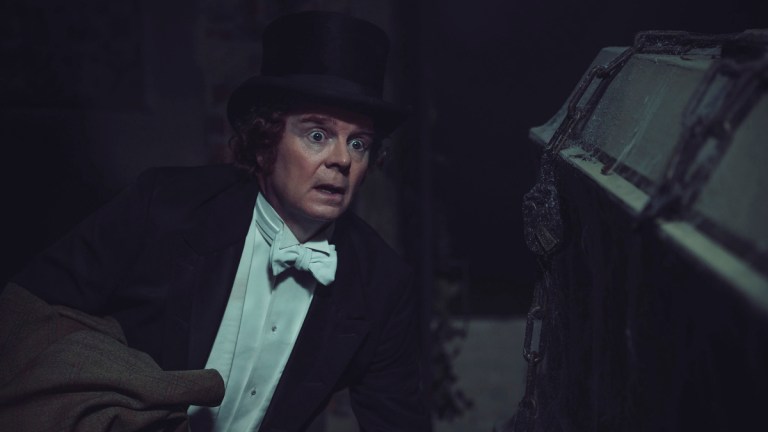Mark Gatiss’ Count Magnus Wants to Scare You For Christmas
Mark Gatiss tells Den of Geek about his new M.R. James ghost story for Christmas, the one he had to abandon in the pandemic, and his take on the supernatural.

Count Magnus, this year’s BBC Christmas ghost story special, blends the holiday spirit of reconnecting with family origins with the terror of reawakening a supernatural being that should have been left alone. Although many may associate the concept with the ghosts that haunt Scrooge in A Christmas Carol, UK TV viewers traditionally welcome the holiday season with filmed adaptations of M.R. James’ early 20th-century ghost stories, a BBC tradition revived by Mark Gatiss since 2013.
In this year’s M.R. James adaptation, Jason Watkins plays Wraxhall, a man digging into his distant ancestors from Sweden. His curiosity leads him to the final resting place of Count Magnus, a 16th-century noble who died mysteriously after a trip abroad. He receives multiple warnings that the crypt is haunted but he insists on opening up the tomb.
Den Of Geek spoke to screenwriter, director and actor Mark Gatiss to get the inside scoop on why he picked Jason Watkins to play the lead role in Count Mangus, his views on the supernatural, and the original script that was ruined by the pandemic.
DEN OF GEEK: What was the inspiration to adapt the M.R. James Ghost Stories?
MARK GATISS: I grew up with the BBC versions in the 1970s. I have particularly strong memories of a couple of them. Ghost stories are my favorite thing in the world. And I guess I remember, it must have been about 2005, I actually went to the BBC with a proposal to do a new one because they’d sort of stopped doing them in the early ’80s, really. They sort of fell out of fashion. It’s just been an ongoing love affair. And James obviously is the master. Everyone acknowledges that he’s the greatest. And although there are lots of other people I’d love to do [adapt], and also other people would love to do, we do tend to come back to him because he goes together with Christmas like chocolate and orange.
Do you consider Count Magnus and the other Christmas ghost stories period dramas or traditional horror?
Count Magnus is a period drama. It’s set in 1863, so it’s inevitable, and there’s great joy in that. It’s something that the BBC has always done very well. I think we sort of associate the BBC with it. I mean, I’ve tackled [these adaptations] a few times over the years, and sometimes it becomes about which [decade to set the story] in. The first one I did was The Tractate Middoth, set in the 1950s. Last year’s story, The Mezzotint, is set in the ’20s. I chose that [setting] just because I hadn’t seen one done in the ’20s. For Count Magnus I thought it’d be nice to do a very Victorian one, albeit in Sweden, so it’s a slightly different flavor. I based the look of Jason’s [Watkins] character on Lewis Carroll. There are some very famous photographs of him with his curly hair and his slightly clerical look. That was the inspiration for that [costume]. The 1860s, again, is a time that’s not often done so it presents those kinds of challenges.
Where was Count Magnus filmed?
I’d love to have gone to Sweden but we couldn’t afford it so we shot it in England. However, I have an almost entirely Scandinavian cast. Count Magnus famously eluded Lawrence Gordon Clarke in the ’70s for the reason of expense and it’s always been slightly the one that got away. And then I suddenly thought, the story itself is quite straightforward. There are not many people in it, it’s not full of vehicles or crowds, it’s just the fact it’s not set in England, which is the tricky bit. I thought if I can convince people we’re in Sweden then it’s doable and that’s what I did.
Can you talk about the casting process for Count Magnus?
I’ve known Jason Watkins for years, and he’s such a wonderful actor and he fits his character, Wraxhall, really perfectly. Watkins was such a joy to work with. [Scheduling] was very hard to fit in because he was filming two other [projects]. but he was really keen to make it work. I’m so glad we got him.
I think [Jason fits] because the very first one of these [M.R. James adaptations] was Jonathan Miller’s Whistle and I’ll Come to You in 1968 which is a benchmark for [these dramas]. Miller cast Michael Horton who is a very funny actor. I remember saying to Jason, when I first talked to him about it, that I think Wraxhall is the most Michael Horton [style character] that I’ve done. Wraxhall is a pompous, middle-aged Englishman who thinks he knows everything. And he sort of loves the sound of his own voice and he loves his own company.
Watkins just brings this wonderful kind of English [attitude] and funniness to [the role]. It’s also slightly enjoyable to see Wraxhall come crashing down. Sometimes M.R. James‘ characters are given terrible punishments for very minor indiscretions. There is a certain delight in watching Wraxhall fall from grace because he’s a prick. The alternative title for Count Magnus [should be] “Red Flags, He just keeps ignoring all these people just going, “uh oh, oh no.”
Has working on Count Magnus and the other Christmas ghost stories changed your view on the supernatural?
There’s no such thing [as ghosts]. But I’m a sort of hopeful skeptic. I think there’s something in it. I don’t think it’s dead people coming back to life, or I don’t believe in the soul, I don’t believe in God, but I think there’s something in it. Otherwise, there wouldn’t be a thousand-year-old tradition like there is.
There’s something in [ghosts]. I think, at the risk of debunking it too much, I think it’s probably more in the realm of physics than it is in the supernatural. I remember talking to a physicist once about the multiverse, and I said, “Do you believe in it? Do you believe that when you drive your car to work there is another version of you that is walking to work? There is another version of you that never did this job. There’s another version of you which is not you?” And he said, “Yes completely. That’s quantum physics.” But you can’t really think about that all the time or your head would explode. And if you think about that as the generally accepted pattern of what physics is, then the idea that time jumps tracks, or sometimes you can see [patterns] if you look.
My house is 200 years old. If I looked in the corner and suddenly saw a man in 18th-century clothes just for a second, it’s not completely out of line with what physics teaches us. I think it’s more likely to be some sort of time thing than it is ghosts as it were. I love everything about [ghosts], and I love the storytelling tradition, and I love the idea of it. I’ll tell you what really fascinates me. I think ultimately the reason that the ghost story endures is that even if it’s a slightly pessimistic view of the afterlife, it means there is something more.
Are there any other stories in particular that you have used as inspiration in the adaptation process?
I think the acknowledged influence is probably EC Comics, because for instance, The Mezzotint, which I did last year, doesn’t really have an ending. I wrote a new ending, which again, where Rory Kinnear’s character is horribly punished, but that’s a very easy ending. It’s a sort of nasty revenge, and those stories are very grizzly. I think somewhere between M.R. James and EC Comics is where my head lies.
Speaking of changing endings, how much of M.R. James’ original text is on the screen in Count Magnus and how much of that is your own making?
It’s very faithful. I like, wherever possible, to be faithful to the original writer because they haven’t made a mistake by writing something which is a classic. Sometimes people seem to think that “well I know this novel has endured for 150 years but I’m going to throw it out the window”. You always need to [add] something to make a short story into a half-hour drama, or an hour drama, or sometimes you can take the elements of something. But in a similar way to Sherlock, we went back to [Arthur] Conan Doyle and restored a lot of things that people had forgotten about. I’m a big fan of doing that. If you know Count Magnus, you will certainly know this story. Equally, there’s a lot of fun to be had from embellishing things and creating new characters. Jason’s character Wraxhall stays with a Swedish family, but they’re never characterized. I’ve made them into a person and given them life.
What’s been your approach to casting these adaptations for a modern audience, because the original M.R. James stories obviously don’t feature characters from diverse backgrounds?
I’ve made very strenuous efforts with [casting] Anjli Mohindra in The Dead Room, Sacha Dhawan in The Tractate Middoth, and Nikesh Patel in The Mezzotint to make sure it isn’t just a parade of middle-aged white men. However, the M.R. James archetype is exactly that.
But to me it’s much more about, if you’re able to, to try and find a diversity of stories to tell. I wrote [a story], not an M.R. James story, an original, which was going to have a woman in the lead [role], However, the pandemic kiboshed that one. I have to say I’m very proud of having proper diversity within a format which could look like it’s only going to be very white and middle-aged.
The half-hour one-off doesn’t really exist anymore and it’s a very difficult slot to get every year. The choice of story isn’t entirely down to me, a lot of people have to agree. What they end up really agreeing on is another M.R. James because he’s the most famous, et cetera.
Have you begun planning the next Christmas ghost story?
That’s the problem. I wish I could guarantee there’d be one, but it’s a struggle. I’m very thrilled. I collect all the press that says “a new Mark Gatiss ghost story is now as traditional as mince pies at Christmas”. I always keep them so I could show them to people and say, “Look, people demand it.” But [these M.R. James adaptations are] a tough one to finance because it’s a half hour, a, one-off. Packaging them on US BritBox is very helpful actually because then you’ve got a sort of season, a sequence of them. I finished [Count Magnus in mid-December] and it’s on next week. So we shot it much later in the year. We can pull a production together quite quickly. I certainly have plans for next year, if we are blessed enough to get another one.
Count Magnus will be available for viewing on US Britbox, BBC Two, and BBC iPlayer on December 23rd. The previous productions in the series: The Tractate Middoth, Dead Room, Martin’s Close, and The Mezzotint, are also available on US Britbox and BBC iPlayer in the UK.
